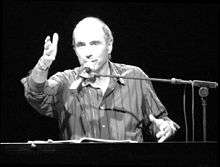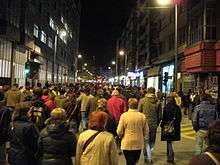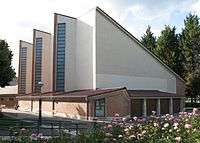Massacre of 3 March 1976 in Vitoria



The massacre of 3 March 1976 in Vitoria is the massacre that took place on March 3, 1976, in the Basque capital during the so-called Spanish Transition: in a day of strike, the Spanish armed police used tear gas to force the workers out of the parish where they were gathering in assembly. As the workers left the Church of San Francisco de Asís, in the working-class neighbourhood of Zaramaga, they were shot by the police. This resulted in 5 dead workers and 150 injured with gunshot wounds. The same police described the facts as a massacre. These facts inspired Lluís Llach celebrated song Campanades a morts.[1][2][3][4][5][6][7]
Background

During the month of January 1976, some six thousand workers initiated a strike against the decree to limit wage increases and in defence of better working conditions. Two months later they called for the third time for a general strike that was massively followed on the 3 of March. This same day the armed police entered the Church of San Francisco in Vitoria-Gasteiz were the workers were gathering and asked them to leave despite the opposition of the priest and the agreement signed by the Catholic Church and the Spanish Government stating that the police was not to enter any churches by force. Just a few seconds later the police used tear gas inside the church, which was crowded. As suffocating workers tried to escape they were beaten up and shot by the Spanish police.
Pedro María Martínez Oci, 27, Francisco Aznar Clemente, 17, Romualdo Barroso Chaparro, 19, and José Castillo, 32, were shot dead. Bienvenido Pereda died later on. Hundreds more were injured, many with gunshot wounds.
That same week Manuel Fraga Iribarne then Home Minister and founder of the Spanish Conservative Party, Rodolfo Martín Villa, Minister of Unions and General Campano, director of the Civil Guard, visited some of the injured workers in an effort to minimize criticism. The leader of the German social-democrats, the SPD, cancelled a meeting with Fraga that same week.
Consequences
Those incidents fueled the action of the democratic opposition and their coordination. The Democratic Junta of Spain and the Platform of Convergence merged into the Democratic Coordination or Platajunta on 26 of March. This new board exerted more political pressure on the government, demanding amnesty, freedom for unions, democracy and denouncing cosmetic reforms. Manuel Fraga Iribarne and Martín Villa are considered responsible for the massacre.
The events also showed once again that the Catholic Church was no longer supporting the dictatorship and in some aspects was much closer to workers demands.
Reparation and recognition of the victims
After the investiture of José Luis Rodríguez Zapatero to the presidency of the Spanish government, the group of the Basque Nationalist Party in the Senate issued a question enquiring about the events and calling for an investigation.[8] In 2006, the law of Historical Memory considered the victims to be victims of the dictatorship, in spite of the fact that this happened 5 months after Francisco Franco's death in November 1975. However, by February 2008, no political responsibilities had been determined, with the Spanish Conservative Party (PP) opposing a public appearance of Manuel Fraga and Rodolfo Martin Villa, Ministers at the time of the event, to face questioning on the matter.[9]
On March 3, 2006, Lluís Llach sang Campanades a Mort, a song that gave name to a disc inspired by the massacre of 3 March in Vitoria-Gasteiz in the very same city.[10] In February 2016 the mayor of Vitoria-Gasteiz tried to honour the Catalan singer-songwriter declaring him adopted son of the Basque capital but the local council members of the Spanish Socialist Workers' Party and the Conservatives made it impossible.[11]
The police recording
The police recording showing how the police were very much aware of what was going on and in fact planned the shooting of workers shocked many in Spain and elsewhere.
References
- ↑ «Masacre del 3 de marzo en Vitoria-Gasteiz (1976)», Biblioteca i Centre de Documentació de l'Artium, Vitòria.
- ↑ Lluís DANÈS: Llach, la revolta permanent, Mediapro / Bainet Zinema, 2006.
- ↑ «Andoni Txasko: 'La nostra pretensió era de fer seure Fraga al banc dels acusats'».
- ↑ «Lakua homenajea a los trabajadores tiroteados por la Policía Armada en 1976», El Mundo, 3 de març del 2012.
- ↑ «Las cuentas pendientes de don Manuel», Deia, 17 de gener del 2012.
- ↑ «Los fantasmas de Fraga», Público, 17 de gener del 2012.
- ↑ «El día en que la policía de Fraga disparó contra una asamblea», Público, 18 de gener del 2012.
- ↑ http://www.senado.es/legis8/publicaciones/html/textos/I0039.html Boletín oficial de las Cortes Generales, Senado, VIII legislatura,nº 39, 18 de juny de 2004]
- ↑ Malaina, Guillermo (2008-02-13). "Los fantasmas de Fraga". Público. Retrieved 2016-07-15.
- ↑ http://www.lluisllach.cat/espanol/actua_45.htm
- ↑ http://www.elperiodico.com/es/noticias/politica/pse-rechaza-lluis-llach-hijo-adoptivo-vitoria-4886867
Coordinates: 42°51′21″N 2°40′08″W / 42.8558°N 2.6689°W